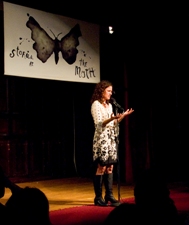Today on the Storyboard, we wanted to consider one of Achenbach’s points—the idea that stories themselves will never be obsolete. We hoped to find out what happened to the oral storyteller’s union once writing emerged. Unfortunately, the Storytellers Union is a little elusive, though there’s an intriguing home page for a site coming soon. Barring progress on that front, we decided to see how spoken-word stories are faring after being supplanted by not only writing but also print and electronic stories.

It turns out that in some places, spoken-word stories are thriving. Last night in Boston, the Moth, that 800-pound gorilla of live storytelling, put on a show at the Tsai Performance Center. At the event, researcher and Harvard instructor Irene Pepperberg told the story of her three decades of work with Alex the parrot, which ended with his death in 2007.
Pepperberg has also written books, but notes the differences between written and spoken stories. “It’s the conciseness,” she says. She also says that “with writing, you can go into all these details. What comes out is the absolute finished product. With storytelling, you can polish and make changes, but the version you deliver on a given night is the only one that audience will get.”
Executive and creative Director of the Moth, Lea Thau had additional thoughts to share on storytelling. While some of it outlines the differences between written and spoken stories, a lot of it seems relevant to narrative journalism:
“Working with storytellers, we ask questions like, ‘What is the story in one sentence? Or even two words—what are you going from and what are you going to?’ In all forms of writing, you have to have themes. But in writing you can have many more themes. For the Moth, you really do need to have one theme for one story. Your story about going skydiving for your 50th birthday could be any of five stories, depending on what is the deeper story of your life. The very important thing in storytelling is to choose, so you have an organizing principle for your piece and you can give the audience a rope to hang onto.”
To get the whole skinny on what narrative journalists can learn from the storytellers who have survived, read the full interview.


